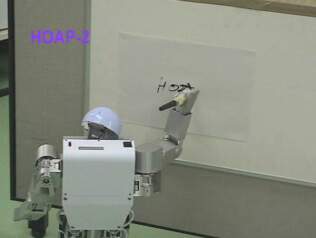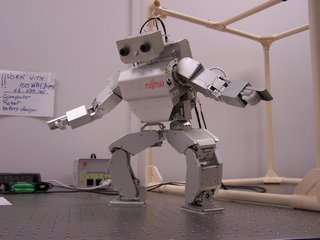Robot Colonists on the Moon
The folks at NASA JPL Evolvable Hardware Laboratory have been working on robot companions for the next round of travel to the moon.
They have reasoned that the best mechanical helpers would be humanoid robots. They feel that robots shaped like humans - with arms, legs and stereo vision - are the best partners for construction and everyday living on the moon and Mars.
They admit that there is need for "extension" robots which extend human capabililties for sensing, strength and super-human capabilitites. But there is also a need for "replacement" robots which can do all that humans can and more.
Humanoid robots are the best form for replacement robots. Some advantages of humanoid robots are:
-Humanoids are able to operate in human environments
-They can use the same tools as humans
-They can climb ladders and scaffolding
-They can help humans directly in emergencies
Also
- Humans can interact woith them more easily
- Humans accept the familiar shape more readily
- There is highest efficiency in teaching and learning new skills

The training and learning are among the most important considerations for companion robots in space colonies, they conclude. Robots cannot be programmed for everything, they must be able to learn how to adapt and optimize their skills.
One of the key factors of the robot's success may depend not on their ability to learn but on the human's ability to teach. We must be able to pass new skills to robots (and from robot to robot) by training them through demonstration and imitation and not by trying to write millions of lines of code.
Starting in 2004 the group has been using a Fujitsu HOAP-2 (Humanoid for Open Architecture Platform) for development.
 They have been able to get the 50 cm tall guy to recognize objects and colors and do simple moving tasks. They aim is to get the robots to complete simple construction tasks. The next big step would be to upsize to a full-scale humanoid like SARCOS creation, for example.
They have been able to get the 50 cm tall guy to recognize objects and colors and do simple moving tasks. They aim is to get the robots to complete simple construction tasks. The next big step would be to upsize to a full-scale humanoid like SARCOS creation, for example.
When will humanoid robots be our helpers in space?
They have outlined a timeline of humanoid development to match the NASA 'Vision for Space Exploration' established in 2004:
2023- 2030 Include humanoid robot technology in some space missions
2028 - Humanoids assist in lunar habitat assembly
2033 - Humanoid robots build habitats without human intervention
2040 - Robots perform site selection, sample collection and laboratory analysis of samples.
2050 - Robot colonists run large scale commercial mining operations including processing materials, transporting to Earth and energy production.
It seems a long way to robot colonies from today's ability to optimize a walking algorithm on a 2-foot tall robot doll. Robot baby steps.
Humanoid Project
SARCOS high performance humanoid videos
Fujitsu HOAP-2 videos
related: Fujitsu Announces HOAP-3
They have reasoned that the best mechanical helpers would be humanoid robots. They feel that robots shaped like humans - with arms, legs and stereo vision - are the best partners for construction and everyday living on the moon and Mars.
They admit that there is need for "extension" robots which extend human capabililties for sensing, strength and super-human capabilitites. But there is also a need for "replacement" robots which can do all that humans can and more.
Humanoid robots are the best form for replacement robots. Some advantages of humanoid robots are:
-Humanoids are able to operate in human environments
-They can use the same tools as humans
-They can climb ladders and scaffolding
-They can help humans directly in emergencies
Also
- Humans can interact woith them more easily
- Humans accept the familiar shape more readily
- There is highest efficiency in teaching and learning new skills

The training and learning are among the most important considerations for companion robots in space colonies, they conclude. Robots cannot be programmed for everything, they must be able to learn how to adapt and optimize their skills.
One of the key factors of the robot's success may depend not on their ability to learn but on the human's ability to teach. We must be able to pass new skills to robots (and from robot to robot) by training them through demonstration and imitation and not by trying to write millions of lines of code.
Starting in 2004 the group has been using a Fujitsu HOAP-2 (Humanoid for Open Architecture Platform) for development.
 They have been able to get the 50 cm tall guy to recognize objects and colors and do simple moving tasks. They aim is to get the robots to complete simple construction tasks. The next big step would be to upsize to a full-scale humanoid like SARCOS creation, for example.
They have been able to get the 50 cm tall guy to recognize objects and colors and do simple moving tasks. They aim is to get the robots to complete simple construction tasks. The next big step would be to upsize to a full-scale humanoid like SARCOS creation, for example.When will humanoid robots be our helpers in space?
They have outlined a timeline of humanoid development to match the NASA 'Vision for Space Exploration' established in 2004:
2023- 2030 Include humanoid robot technology in some space missions
2028 - Humanoids assist in lunar habitat assembly
2033 - Humanoid robots build habitats without human intervention
2040 - Robots perform site selection, sample collection and laboratory analysis of samples.
2050 - Robot colonists run large scale commercial mining operations including processing materials, transporting to Earth and energy production.
It seems a long way to robot colonies from today's ability to optimize a walking algorithm on a 2-foot tall robot doll. Robot baby steps.
Humanoid Project
SARCOS high performance humanoid videos
Fujitsu HOAP-2 videos
related: Fujitsu Announces HOAP-3
Labels: Lunar robot

0 Comments:
Post a Comment
Subscribe to Post Comments [Atom]
<< Home